#explain simple java hello world program
Explore tagged Tumblr posts
Text
How To Learn Java: Basics, Tips, And Strategies

Programmers of all skill levels continue to utilize Java, one of the most popular programming languages. It is a well-liked option for many technical solutions due to its many applications, community support, and adaptability. If you're considering starting your Java learning journey, here’s how to do it effectively.
Understand The Basics Of Java
Before diving into coding, it's important to familiarize yourself with Java’s foundational concepts. Here’s what to start with:
Syntax and Structure: Java's syntax is similar to C and C++, making it easier to switch from other languages. Understanding basic structures such as loops (for, while), conditionals (if-else), and data types (int, float, char, etc.) is crucial.
Object-Oriented Programming (OOP): Java is an object-oriented language, so grasping OOP principles is essential. Learn about classes, objects, inheritance, encapsulation, polymorphism, and abstraction.
Java Development Kit (JDK) and Integrated Development Environment (IDE): Set up your development environment by installing the JDK and choosing a beginner-friendly IDE like Eclipse or IntelliJ IDEA. These tools help streamline your coding experience.
Java Virtual Machine (JVM): Understanding how the JVM works provides insight into Java’s “write once, run anywhere” capability. The JVM ensures that Java code runs seamlessly on any platform. Additionally, Elevate your coding skills with top-notch Java Training In Chennai at Infycle Technologies, where expert instructors guide you from basics to advanced levels.
Start With Simple Programs
Start coding simple programs to practice the basic concepts you learn. For example, write a program to print “Hello, World!” or create a calculator that performs basic arithmetic operations. This will help solidify your understanding of the syntax and logic.
Utilize Online Learning Resources
To complement your practice, make use of the plethora of online resources available:
Video Tutorials: Platforms like YouTube and Udemy offer free and paid tutorials that explain Java concepts in a visual and engaging way.
Interactive Coding Platforms: Websites such as Codecademy, HackerRank, and LeetCode provide interactive coding challenges that enhance problem-solving skills.
Documentation and Books: The official Java documentation and books like “Head First Java” or “Effective Java” are excellent for deep dives into Java topics.
Apply Practical Strategies
Here are a few strategies to keep in mind:
Practice Regularly: Consistency is key in learning any programming language. Dedicate at least 30 minutes to an hour each day to code and review new concepts.
Work on Projects: Applying what you learn to real-world projects enhances your coding skills and helps you build a portfolio. Start with simple projects like creating a to-do list app or a simple game.
Join Coding Communities: Being part of coding forums like Stack Overflow or Reddit’s r/learnjava can provide you with support, advice, and solutions to common problems.
Debugging: Learn how to use Java’s built-in debugging tools. Developing this skill will help you identify and resolve errors more efficiently.
Stay Motivated
Learning Java (or any language) takes time and persistence. Celebrate small wins, stay patient, and remember that every expert coder was once a beginner. Over time, as you progress from basic syntax to more complex concepts like multi-threading and frameworks (such as Spring or Hibernate), your skills will become more robust. With thorough Python Training in Chennai at Infycle Technologies, you may improve your coding abilities and open up new employment prospects.
Conclusion
At first, learning Java may seem overwhelming, but with the correct strategy, it can be gratifying and manageable. Begin with the basics, practice diligently, leverage available resources, and keep experimenting with new projects. Soon, you'll find yourself confidently coding and ready to take on more advanced topics.
0 notes
Text
Python Unveiled: A Beginner's Odyssey into the World of Coding Magic
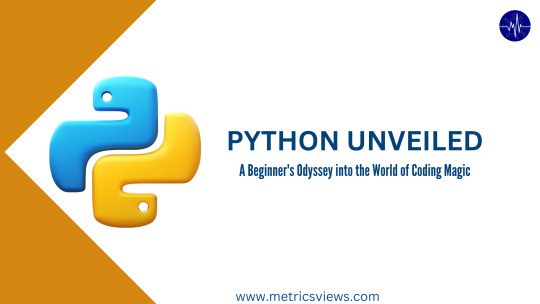
Installation:
Visit the official Python website: https://www.python.org/downloads/windows/
Click the appropriate link for your system to download the executable file: Windows installer (64-bit) or Windows installer (32-bit).
Run that downloaded executable installer file. For example, python.exe file.
Click Install to start the installation.
After the installation is complete, a Setup was successful message is displays.
To verify python installation:
Enter the code: python --version

Now you are ready to start learning and programming in Python.
Quick Summary:
Python has syntax that allows developers to write programs with less lines than some other programming languages. Python runs on an interpreter system. Python is a computer programming language often used to build websites and software, applications ,conduct data analysis.
Targeted Audience:
This article is intended for those people interested in learning the fundamentals of python development. It will be useful for freshers, backend developers, students. and for those who are lazy to write lengthy code because python has easy, simple syntax which includes short code.
Use Cases:
Web development -framework: Django, Flask, FastAPI, etc.
Data analysis - Pandas, NumPy
Game development - Pygame
Education and teaching programming concepts
Let’s see what Python is:
Definition:
Python is a high-level, general-purpose, interpreted object-oriented programming language and it is used to build websites and software.
Python code tends to be short and when compared to compiled languages like C and C++, it executes programs slower.
Features:
Easy to Learn and Use:
Python is easy to learn and simple as compared to other languages. Its syntax is straightforward.
There is no use of the semicolon or curly-bracket in syntax.
It is the most suggested programming language for beginners.
Interpreted Language:
Interpreted means program executes single line at a time.
The advantage of being interpreted language, makes it debugging easy and portable.
Expressive Language:
For Ex.: If you want to print small program you simply type print ("Hello World"). It will take only single line to execute, while Java or C takes multiple lines.
Free and Open Source:
Python is freely available for everyone. open-source means, "Anyone can download its source code without paying a single rupee.
Object-Oriented Language:
Python supports object-oriented language and concepts of classes and objects. It supports inheritance, polymorphism, and encapsulation, etc.
Syntax:
demo.py :- File name

How to run python file:
python myfile.py // here my myfile is name of program.

Python Comments:
Comments are often used to explain Python code. "#" used for commenting.
For Ex: # Printing hello world

Variables:
Variables are like containers it stores data values.
For Ex: x = 5 //x is a variable

Data Types:
String: In String datatype, we can store string values.

int: In int datatype, we can store int values.

float: In float datatype, we can store float values.

list: lists are always stored in square brackets [ ] .

tuple: tuples are always stored in round brackets ( ) .

dict: In Dictionaries, we store key value pair.

Function:
A function is a reusable block of code that performs some specific tasks. it only runs when it is called.
You can pass data, known as parameters in a function.
here : demo_function is function name. It can be anything.

Arrays:
Arrays are used to store multiple values but with same datatype.

To check length of an array
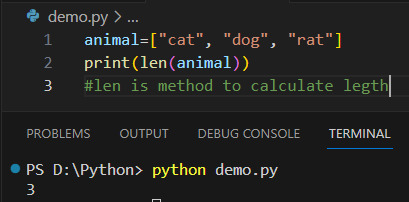
To add elements in array we use append method. For ex.: animal.append("fox")
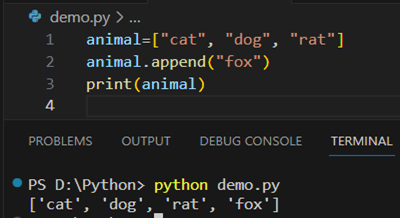
To delete elements in array we use pop method. it deleteindex wise.For Ex:animal.pop(1)
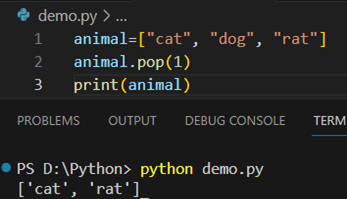
Removes all the elements from the list. Method:- clear()
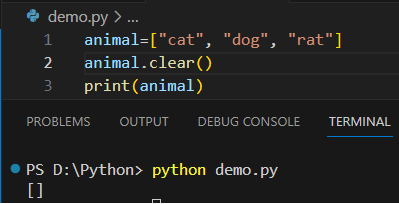
Returns the number of elements with the specific value. Method: count()
It will return index value of 4 that is 1.
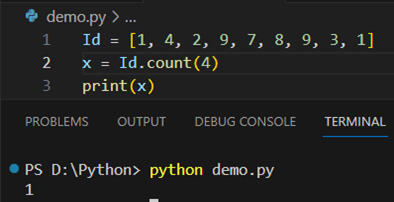
Adds an element at the specified position.Method:- insert()
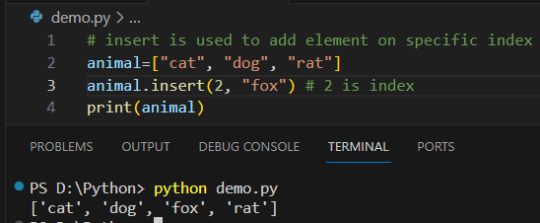
Removes the first item with the given value. Method: remove()

Reverses the order of the list. Method: reverse()
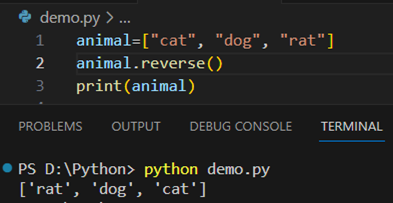
Sorts the list. Method: sort()
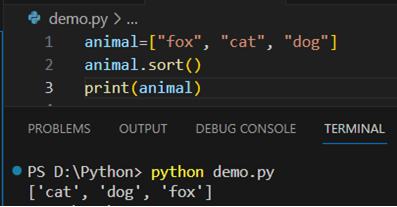
Class:
Class is a blueprint of an object.
It defines the structure and behavior of objects of that class.
The class keyword is used to define a class.
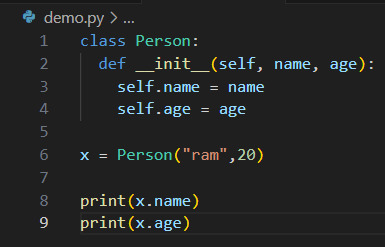
Object:
An object is an instance of a class and a collection of attributes and methods.
For ex.: x = Person("ram", 20)
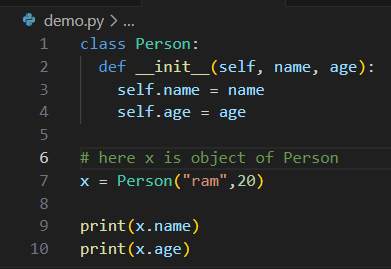
Inheritance:
Inheritance is a OOP concept that allows you to create a new class based on an existing class. The new class inherits attributes and methods from the existing class, which is referred to as the base or parent class. The newer class is called the derived or child class of the base class.
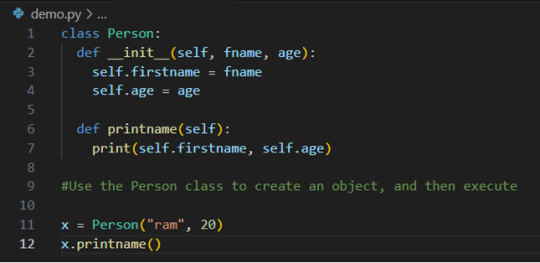
Polymorphism:
polymorphism means having many forms.
Method Overloading (Compile-Time Polymorphism):
having same name but different parameters.
Method Overriding (Run-Time Polymorphism):
having same name and same parameters.
Encapsulation:
simple lang. wrapping or hiding of data.
object has ability to hide data and behavior that is not necessary to use.
How to take User Input: For ex.
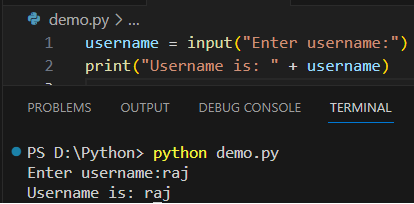
Closing Thought:
Python is a powerful and versatile programming language that has become an integral part of the technology. Everyone is using Python because of its simple syntax, and if you are a beginner, you should definitely go with python.
Credit – Priyanka Divekar
MetricsViews Pvt. Ltd.
MetricsViews specializes in building a solid DevOps strategy with cloud-native including AWS, GCP, Azure, Salesforce, and many more. We excel in microservice adoption, CI/CD, Orchestration, and Provisioning of Infrastructure - with Smart DevOps tools like Terraform, and CloudFormation on the cloud.
www.metricsviews.com.
0 notes
Text

A Beginner's Guide to Programming in Java: A Human-Friendly Approach
Programming in Java can seem daunting at first, but with the right guidance and a step-by-step approach, anyone can learn to code in this powerful language. In this blog post, I will walk you through the process of programming in Java, explaining each step in a human-friendly manner. So, let's dive in and embark on this exciting journey together!
Step 1: Setting Up Your Development Environment To start programming in Java, you'll need to set up your development environment. Begin by downloading and installing the Java Development Kit (JDK) from the official Oracle website. Once installed, you can use any text editor or Integrated Development Environment (IDE) of your choice to write your Java code.
Step 2: Understanding the Basics of Java Syntax Java is an object-oriented programming language, which means it revolves around creating and manipulating objects. Familiarize yourself with the basic syntax of Java, such as how to declare variables, write loops, and define functions. Understanding these fundamental concepts will lay a solid foundation for your Java programming journey.
Step 3: Writing Your First Java Program Now that you have your development environment set up and a basic understanding of Java syntax, it's time to write your first Java program. Start with a simple "Hello, World!" program, which will display this classic message on the screen. This exercise will help you grasp the structure of a Java program and how to execute it.
Step 4: Learning Java Data Types and Variables Java offers various data types, such as integers, floating-point numbers, characters, and booleans, to store different kinds of information. Dive deeper into the world of data types and learn how to declare variables to store and manipulate data in your Java programs.
Step 5: Controlling Program Flow with Conditional Statements and Loops Conditional statements, like if-else and switch-case, allow your program to make decisions based on certain conditions. Loops, such as for, while, and do-while, enable you to repeat a block of code multiple times. Mastering these control structures will give you the power to create dynamic and interactive Java programs.
Step 6: Understanding Object-Oriented Programming (OOP) Concepts Java's strength lies in its object-oriented nature. Dive into the world of OOP and learn about classes, objects, inheritance, polymorphism, and encapsulation. These concepts will help you write modular, reusable, and maintainable code.
Step 7: Exploring Java Libraries and APIs Java provides a vast collection of libraries and Application Programming Interfaces (APIs) that extend its functionality. Discover popular libraries like Java Standard Library, JavaFX, and third-party libraries that can simplify complex tasks and enhance your Java programs.
Step 8: Debugging and Troubleshooting As a programmer, you'll encounter errors and bugs in your code. Learn how to effectively debug and troubleshoot your Java programs using tools like breakpoints, logging, and error handling techniques. Debugging skills are essential for every programmer's toolkit.
Step 9: Practicing and Building Projects The best way to solidify your Java programming skills is through practice. Start small by solving coding challenges and gradually move on to building your own projects. Join online coding communities, participate in coding competitions, and collaborate with fellow programmers to enhance your skills.
Congratulations! You've completed the step-by-step guide to programming in Java. Remember, programming is a continuous learning process, so keep exploring new concepts, experimenting with code, and challenging yourself. With dedication and practice, you'll become a proficient Java programmer in no time. Happy coding!
0 notes
Text
Why We Use Oops Concept in Python Programming
Python is a powerful, high-level, and widely used programming language. We may create apps utilising an Object-Oriented methodology thanks to it. Classes and objects are simple to build and utilise in Python. By doing so, it concentrates on creating reusable code. Making things is a common approach to issue-solving. All cutting-edge software development, machine learning applications, and web development employ the most recent Python 3 version. It is a good toolkit for both new and seasoned programmers who are familiar with languages like C++ and Java. In essence, Python is not a fully object-oriented programming language like Java or some other ones. This means that Python has dependable, concise syntax and provides the oops notion with or without any issues. It also provides the following benefits to the coder.

Easy to Learn & Code
Free and High-Level Language
Portable
Large Collection of Packages and Modules
Why the object-oriented (oops) concept?
Then why do we need Oops in Python when everything is working properly? After all, as we all know, oops (object-oriented programming) also offers some advantages to programming languages like:
Modularity for simpler problem-solving
Reusing code by inheriting it
Adaptability via polymorphism
Successful problem-solving, etc.
These ideas elevate Python to a more distinctive, well-known, and contemporary language. Let's begin an in-depth study of how Python's Oops pillars function. Check out the Python course online to learn more about the Oops concept.
Oops Concept
Python is a great programming language that supports Object-Oriented Programming systems and is called OOPS.
Class
Objects
Encapsulation
Inheritance
Polymorphism
Abstraction
Python Class
A class is a group of related items. The models or prototypes used to generate objects are included in classes. It is a logical entity with a few methods and characteristics.
Let's use an example to help you understand why classes are necessary. Suppose you wanted to keep track of the number of dogs that might have diverse characteristics like breed and age. If a list is utilised, the dog's breed and age might be the first and second elements, respectively. What if there were 100 different breeds of dogs? How would you know which ingredient should go where? What if you wanted to give these dogs additional traits? This is disorganised and just what classes need.
Some points on Python class:
The term class is used to create classes.
The variables that make up a class are known as attributes.
With the dot (.) operator, attributes can always be retrieved and are always public. For example: Myclass.Myattribute
Objects in Python
The object is an entity that is connected to a state and activity. Any physical device, such as a mouse, keyboard, chair, table, pen, etc., may be used. Arrays, dictionaries, strings, floating-point numbers, and even integers are all examples of objects. Any single string or integer, more specifically, is an object. A list is an object that may house other things, the number 12 is an object, the text "Hello, world" is an object, and so on. You may not even be aware of the fact that you have been using items.
An object includes:
State: An object's properties serve as a representation of it. Additionally, it reflects an object's characteristics.
Behaviour: The methods of an object serve as a representation of behaviour. It also shows how one object reacts to other objects.
Identity: It gives a thing a special name and makes it possible for one object to communicate with another.

Let's use the example of the class dog (described above) to better grasp the state, behaviour, and identity.
The identity may be regarded as the dog's name.
Breed, age, and colour of the dog are examples of states or attributes.
You may infer from the behaviour whether the dog is eating or sleeping.
Encapsulation
It explains the concept of data wrapping and the techniques that operate on data as a single unit. This restricts direct access to variables and procedures and can avoid data alteration by accident. A variable can only be altered by an object's method in order to prevent inadvertent modification. These variables fall under the category of private variables.
A class, which encapsulates all the data that is contained in its member functions, variables, etc., is an example of encapsulation.
Inheritance
One class's ability to derive or inherit properties from another class is known as inheritance.
The advantages of inheritance include:
It accurately depicts relationships in the real world.
It offers a code's reusability. We don't need to keep writing the same code. It enables us to expand a class's functionalities without changing the class itself.
Because it is transitive, if class B inherits from additional class A, all of class B's subclasses will also automatically inherit from class A.
Types of Inheritance
Single Inheritance: A derived class may take traits from a single-parent class through single-level inheritance.
Multi-level Inheritance: A derived class can inherit properties from an immediate parent class, which in turn inherits properties from his or her parent class.
Hierarchical Inheritance: More than one derived class can inherit properties from a parent class thanks to hierarchical-level inheritance.
Multiple Inheritances: A derived class can inherit properties from multiple base classes thanks to multiple-level inheritance.
Abstraction
Abstraction is used to conceal from users the internal workings of a function. Users can only interact with the function's fundamental implementation; its secret inner workings. Although the user is aware of "what function does," they are unaware of "how it does."
Polymorphism
Polymorphism refers to the existence of various forms. Polymorphism in programming refers to the usage of various types with different signatures for the same function.
Conclusion
If you are a Python programmer, you can learn more about the OOPS concept by checking out the online Python course.
Tags: #onlinecertificatepython #bestpythononlinetraining #Toptenonlinetrainingpython #PythonCourseOnline #PythonCertificationCourse
0 notes
Video
youtube
Explanation of Java Hello World Program by Deepak (Part 1)
#Explanation of Simple Java Program by Deepak#Explanation of Simple Java Program#explain simple java hello program#explain simple java hello world program#explain simple java hello program in hindi#java hello world program#compile java program#run java program#java tutorials#java tutorials in hindi#java tutorials by deepak
0 notes
Text
Day 15 : Grumpy Git Returns 11
Hello people, here we are again at the well of infinite misery. Pondering what hell today will bring with it. As usual the tech world is more than adequate at delivering misery firmly to your door.
So on that joyously somber note I take another delve into the eternal pit so you don't have to. Today's discussion is ...
WSL is anyone actually using it, and can we trust it...
WSL is a Microsoft product and to give it it's full title ... Windows Subsystem for Linux. Now that immense mouthful basically is a compatability layer that allows certain Linux programs and files to be ran under Windows.
Now recently it has been updated to version 2.0 but very few people used version 1. So who is it aimed at, primarily its aimed at developers who wish to write a piece of software and see if it can be ran in Linux.
As far as I'm aware it has a very basic graphics driver and in version 1 I believe it was purely terminal based applications that would run.
Now I don't think I need to go into the Microsoft vs Linux debate as I am sure it's been debated to death. But Microsoft are now members of the Linux Foundation board and are trying to embrace Linux to some degree.
First there was Azure Sphere OS which is a Linux distribution completely ran by Microsoft. Now WSL is designed so you can run Linux programs under Windows.
This is a complete turn around obviously for Microsoft since the notorious Steve Ballmer days where he declared Linux as a cancer. However even with Microsoft embracing the Linux culture. it doesn't naturally follow suit that the Linux community has embraced them.Many still think Microsoft are implementing their EEE philosophy. For those who have no idea what that is I will explain it.
The first E stands for Embrace, where Microsoft show an interest in a product they have had no interest in whatsoever previously and suddenly keep going on like its the best thing since sliced bread. So far pretty simple.
The second E is Extend, now this is where Microsoft write a program using said new product and adds features exclusive to the Microsoft platform which don't necessarily follow the previous ones. For example Sun Microsystems (Oracle) sued Microsoft for modifying the JVM (Java Virtual Machine) because Microsoft added features which no other JVM had and the idea of the JVM was it was universal. Sun won this case and the Microsoft JVM has been replaced with the standard JVM in every version of Windows since.
The third E is Extinguish now this is the scary one. Microsoft push their way into a market, twiddle with it then the original version is seen as inferior. So more people use the Microsoft version putting the original version into either liquidation or making it seem archaic and obsolete. Just look at Word Perfect for an example of that. They were one of the biggest suppliers of word processing software but Microsoft created Office. Was it a better product not necessarily but it became the norm. Now many will say you can still buy Word Perfect software. You probably can but it put the Word Perfect Corporation almost out of business and since then the property has passed from company to company such as Novell, Corel and I think its owned by a venture capitalist company now.
So it's easy to see the Linux community concerns. So far they have had the Embrace of them joining the Linux Foundation, WSL is been seen as the Extend phase so many are wondering wen Microsoft start the Extinguish phase.
I think also what doesn't help matters is Canonical the people behind Ubuntu seem to be working with Microsoft to enhance WSL. Now many have speculated regarding ho Canonical have become something strange. Many speculating they really needs a buyer. Microsoft is the one company that could quite easily afford to buy Canonical so its easy to see why people are suspicious.
Is Microsoft just being decent human beings realising Linux's potential now that Sataya Nadella is at the helm. Himself the ex head of the enterprise software division before becoming CEO.
Or is Microsoft just preparing for battle knowing Linux on the desktop is in decline and moving in for the kill.if you look at the server side of things. Microsoft know Linux has them beaten so that's a market they know they can't remove. They themselves use Apache servers to run their online operations.
The desktop version of Linux is definitely waning as the figures suggest. Can they slay Linux at desktop level. Wouldn't be the first time they have tried to do such.
Can Microsoft be trusted, who knows...
0 notes
Text
Extremely Unseen -Live Reverse Engineering Android-Az Screen Recorder !!
Extremely Unseen -Live Reverse Engineering Android-Az Screen Recorder !!
In the name of ALLAH we start
Peace be upon you

Extremely Unseen -Live Reverse Engineering Android-Az Screen Recorder !!
Today, I will show you,how I will apply Live Reverse Engineering on The Latest version of "Az- Screen Recorder" Android App.
Cracking Tutorial Contents :
1- Remove Ads from the App.
2- Enable Premium Features for Free.
Required Tool :
Mt Manager "Recommend Buying Vip Subscription ".
You can Download The Latest version from the Link below by Clicking on Image.

Firstly, if you search for Tutorial about Reserving Engineering on Android Application.
Most of these videos will explain about only decompile and Recompile and in Rare videos they will edit Xml layout,Which is simple and useless editing.
If you want useful tutorial,I Recommend you to search for Live Reverse Engineering as this my Tutorial that modifying "Smali Source Code".
Most of the active Actions in App ,Like Clicking on Buttons and moving to the next Activity , are located in"Smali Source Code".
Honestly modifying "Smali Files" not easy and you must learn Dalvik byteCode .
And you should learn The basics of the Java Programming Language.
To understand how the Machine reading the code,that is very Long and Extremely detailed.
See the differences between the Java and Smali Languages in these simple Examples :
(Java)
public class Main {
public static void main(String[] args) {
System.out.println("Hello World!");
}
}
==================================
(Smali)
.class public LMain;
.super Ljava/lang/Object;
.source "Main.java"
# direct methods
.method public constructor <init>()V
.registers 1
.prologue
.line 17
invoke-direct {p0}, Ljava/lang/Object;-><init>()V
return-void
.end method
.method public static main([Ljava/lang/String;)V
.registers 3
.prologue
.line 20
sget-object v0, Ljava/lang/System;->out:Ljava/io/PrintStream;
const-string v1, "Hello World!"
invoke-virtual {v0, v1}, Ljava/io/PrintStream;->println(Ljava/lang/String;)V
.line 21
return-void
.end method
===================================
For Detailed Tutorial,See the below Video.
youtube
Please don't forget to share this Article with your friends.
May the following articles , attracting your attention :
X-plore Best file xplorer
إحذر كي لا تخدع إفحص الرقم الأمريكي إن كان صالح لتفعيل مواقع التواصل الاجتماعي أو لا قبل الشراء.
8 Methods To Grill UP In Your Holiday !!
(Exclusive best site for generating validate ssn numbers(Us
[INSTALL_FAILED_INVALID_URI] Fixed Now (Root Need ) [Terminal Emulator]. In ALLAH we trust.
======================Here to under==============
Extremely Unseen -Live Reverse Engineering Android-Az Screen Recorder !!
In the name of ALLAH we start
Peace be upon you

Extremely Unseen -Live Reverse Engineering Android-Az Screen Recorder !!
Today, I will show you,how I will apply Live Reverse Engineering on The Latest version of "Az- Screen Recorder" Android App.
Cracking Tutorial Contents :
1- Remove Ads from the App.
2- Enable Premium Features for Free.
Required Tool :
Mt Manager "Recommend Buying Vip Subscription ".
You can Download The Latest version from the Link below by Clicking on Image.

Firstly, if you search for Tutorial about Reserving Engineering on Android Application.
Most of these videos will explain about only decompile and Recompile and in Rare videos they will edit Xml layout,Which is simple and useless editing.
If you want useful tutorial,I Recommend you to search for Live Reverse Engineering as this my Tutorial that modifying "Smali Source Code".
Most of the active Actions in App ,Like Clicking on Buttons and moving to the next Activity , are located in"Smali Source Code".
Honestly modifying "Smali Files" not easy and you must learn Dalvik byteCode .
And you should learn The basics of the Java Programming Language.
To understand how the Machine reading the code,that is very Long and Extremely detailed.
See the differences between the Java and Smali Languages in these simple Examples :
(Java)
public class Main {
public static void main(String[] args) {
System.out.println("Hello World!");
}
}
==================================
(Smali)
.class public LMain;
.super Ljava/lang/Object;
.source "Main.java"
# direct methods
.method public constructor <init>()V
.registers 1
.prologue
.line 17
invoke-direct {p0}, Ljava/lang/Object;-><init>()V
return-void
.end method
.method public static main([Ljava/lang/String;)V
.registers 3
.prologue
.line 20
sget-object v0, Ljava/lang/System;->out:Ljava/io/PrintStream;
const-string v1, "Hello World!"
invoke-virtual {v0, v1}, Ljava/io/PrintStream;->println(Ljava/lang/String;)V
.line 21
return-void
.end method
===================================
For Detailed Tutorial,See the below Video.
Please don't forget to share this Article with your friends.
May the following articles , attracting your attention :
X-plore Best file xplorer
إحذر كي لا تخدع إفحص الرقم الأمريكي إن كان صالح لتفعيل مواقع التواصل الاجتماعي أو لا قبل الشراء.
8 Methods To Grill UP In Your Holiday !!
(Exclusive best site for generating validate ssn numbers(Us
[INSTALL_FAILED_INVALID_URI] Fixed Now (Root Need ) [Terminal Emulator]. In ALLAH we trust.
أندرويد, كل شيء تقني مفيد https://ift.tt/30wrcLw via IFTTT
0 notes
Text
300+ TOP SCALA Interview Questions and Answers
SCALA Interview Questions for freshers experienced :-
1. What is Scala? Scala is a Java-based Hybrid programming language which is the fusion of both Functional and Object-Oriented Programming Language features. It can integrate itself with Java Virtual Machine and compile the code written. 2. How Scala is both Functional and Object-oriented Programming Language? Scala treats every single value as an Object which even includes Functions. Hence, Scala is the fusion of both Object-oriented and Functional programming features. 3.Write a few Frameworks of Scala Some of the Frameworks supported by Scala are as follows: Akka Framework Spark Framework Play Framework Scalding Framework Neo4j Framework Lift Framework Bowler Framework 4. Explain the types of Variables in Scala? And What is the difference between them? The Variables in Scala are mainly of two types: Mutable Variables We Declare Mutable Variables by using the var keyword. The values in the Mutable Variables support Changes Immutable Variables We declare Immutable Variables using the val keyword. The values in Immutable Variables do not support changes. 5. Explain Streams in Scala. In simple words, we define Stream as a Lazy list which evaluates the elements only when it needs to. This sort of lazy computation enhances the Performance of the program. 6. Mention the Advantages of Scala Some of the major Advantages of Scala are as follows: It is highly Scalable It is highly Testable It is highly Maintainable and Productive It facilitates Concurrent programming It is both Object-Oriented and Functional It has no Boilerplate code Singleton objects are a cleaner solution than Static Scala Arrays use regular Generics Scala has Native Tuples and Concise code 7. Explain the Operators in Scala The following are the Operators in Scala: Arithmetic Operators Relational Operators Logical Operators Bitwise Operators Assignment Operators 8. What is Recursion tail in Scala? ‘Recursion’ is a function that calls itself. For example, a function ‘A’ calls function ‘B’, which calls the function ‘C’. It is a technique used frequently in Functional programming. In order for a Tail recursive, the call back to the function must be the last function to be performed. 9. Explain the use of Tuples in Scala? Scala tuples combine a Finite number of items together so that the programmer can Pass a tuple around as a Whole. Unlike an Array or List, a tuple is Immutable and can hold objects with different Datatypes. 10. How is a Class different from an Object? Class combines the data and its methods whereas an Object is one particular Instance in a class.

SCALA Interview Questions 11. Why do we need App in Scala? App is a helper class that holds the main method and its Members together. The App trait can be used to quickly turn Objects into Executable programs. We can have our classes extend App to render the executable code. object Edureka extends App{ println("Hello World") } 12. What are Higher-order functions? A Higher-order function is a function that does at least one of the following: takes one or more Functions as Arguments, returns a Function as its result. 13. Explain the scope provided for variables in Scala. There are three different scopes depending upon their use. Namely: Fields: Fields are variables declared inside an object and they can be accessed anywhere inside the program depending upon the access modifiers. Fields can be declared using var as well as val. Method Parameters: Method parameters are strictly Immutable. Method parameters are mainly used to Pass values to the methods. These are accessed inside a method, but it is possible to access them from outside the method provided by a Reference. Local Variables: Local variables are declared inside a method and they are accessible only inside the method. They can be accessed if you return them from the method. 14. What is a Closure? Closure is considered as a Function whose return value is Dependent upon the value of one or more variables declared outside the closure function. Course Curriculum Apache Spark and Scala Certification Training Instructor-led SessionsReal-life Case StudiesAssessmentsLifetime Access Example: val multiplier = (i:Int) => i * 10 Here the only variable used in the function body, i * 10 , is i, which is defined as a parameter to the function 15. Explain Traits in Scala. A Trait can be defined as a unit which Encapsulates the method and its variables or fields. The following example will help us understand in a better way. trait Printable{ def print() } class A4 extends Printable{ def print(){ println("Hello") } } object MainObject{ def main(args:Array){ var a = new A4() a.print() } } 16. Mention how Scala is different from Java A few scenarios where Scala differs from Java are as follows: All values are treated as Objects. Scala supports Closures Scala Supports Concurrency. It has Type-Inference. Scala can support Nested functions. It has DSL support Traits 17. Explain extend Keyword You can extend a base Scala class and you can design an Inherited class in the same way you do it in Java by using extends keyword, but there are two restrictions: method Overriding requires the override keyword, and only the Primary constructor can pass parameters to the base Constructor. Let us understand by the following example println("How to extend abstract class Parent and define a sub-class of Parent called Child") class Child=(name:String)extends Parent(name){ override def printName:Unit= println(name) } object Child { def apply(name:String):Parent={ new Child(name) } } 18. Explain implicit classes with syntax Implicit classes allow Implicit conversations with the class’s Primary constructor when the class is in scope. Implicit class is a class marked with the “implicit” keyword. This feature was introduced in with Scala 2.10 version. //Syntax: object { implicit class Data type) { def Unit = xyz } } 19. Explain the access Modifiers available in Scala There are mainly three access Modifiers available in Scala. Namely, Private: The Accessibility of a private member is restricted to the Class or the Object in which it declared. The following program will explain this in detail. class Outer { class Inner { private def f() { println("f") } class InnerMost { f() // OK } } (new Inner).f() // Error: f is not accessible } Protected: A protected member is only Accessible from Subclasses of the class in which the member is defined. The following program will explain this in detail. package p class Super { protected def f() { println("f") } } class Sub extends Super { f() } class Other { (new Super).f() // Error: f is not accessible } } Public: Unlike Private and Protected members, it is not required to specify Public keyword for Public members. There is no explicit modifier for public members. Such members can be accessed from Anywhere. Following is the example code snippet to explain Public member class Outer { class Inner { def f() { println("f") } class InnerMost { f() // OK } } (new Inner).f() // OK because now f() is public } 20. What is a Monad in Scala? A Monad is an object that wraps another object. You pass the Monad mini-programs, i.e functions, to perform the data manipulation of the underlying object, instead of manipulating the object directly. Monad chooses how to apply the program to the underlying object. 21. Explain the Scala Anonymous Function. In the Source code, Anonymous functions are called ‘Function literals’ and at run time, function literals are instantiated into objects called Function values. Scala provides a relatively easy Syntax for defining Anonymous functions. //Syntax (z:Int, y:Int)=> z*y Or (_:Int)*(_Int) 22. How do I Append data in a list? In Scala to Append into a List, We have the following methods: use “:+” single value var myList = List.empty myList :+= "a" 23. Why Scala prefers Immutability? Scala prefers Immutability in design and in many cases uses it as default. Immutability can help when dealing with Equality issues or Concurrent programs. 24. Give some examples of Packages in Scala The three important and default Packages in Scala are as follows: Java.lang._ : Java.lang._ package in Java. Provides classes that are fundamental to the design of the Java programming language. Java.io._ : Java.io._ Package used to import every class in Scala for input-output resources. PreDef: Predef provides type aliases for types which are commonly used, such as the immutable collection types Map, Set, and the List constructors 25. Why is an Option used in Scala? Option in Scala is used to Wrap the Missing value. 26. Mention the Identifiers in Scala. There are four types of Scala Identifiers: Alphanumeric identifiers Operator identifiers Mixed identifiers Literal identifiers //Scala program to demonstrate Identifiers in Scala. object Main { //Main method def main(args: Array) { //Valid Identifiers var 'name = "Hari"' var age = 20; var Branch = "Computer Science" println() println() println() } } 27. How do you define a function in Scala? def keyword is used to define the Function in Scala. object add { def addInt( a:Int, b:Int ) : Int = { var sum:Int = 0 sum = a + b return sum } } 28. How is the Scala code compiled? Code is written in Scala IDE or a Scala REPL, Later, the code is converted into a Byte code and transferred to the JVM or Java Virtual Machine for compilation. Big Data Training 29. Explain the functionality of Yield. Yield is used with a loop, Yield produces a value for each iteration. Another way to do is to use map/flatMap and filter with nomads. for (i "#FF0000", "azure" -> "#F0FFFF") 39. Explain Exception Handling in Scala Throw Exception: Throwing an exception looks the same as in Java. You create an exception object and then you throw it with the throw keyword as follows. Throw new IllegalArgumentException Catching an Exception: Scala allows you to try/catch any exception in a single block and then perform pattern matching against it using case blocks. Try the following example program to handle the exception. Example: import java.io.FileReader import java.io.FileNotFoundException import java.io.IOException object Demo { def main(args: Array) { try { val f = new FileReader("input.txt") } catch { case ex: FileNotFoundException ={ println("Missing file exception") } case ex: IOException = { println("IO Exception") } } } } So, with this, we finished some questions on the Intermediate Level. Now, Let us move to the next level of interview questions which happen to be the Advanced Level Interview Questions. 40. Explain Pattern Matching in Scala through an example A Pattern match includes a sequence of alternatives, each starting with the Keyword case. Each alternative includes a Pattern and one or more Expressions, Scala evaluates whenever a pattern matches. An arrow symbol => separates the pattern from the expressions. Try the following example program, which shows how to match against an integer value. object Demo { def main(args: Array) { println(matchTest(3)) } def matchTest(x: Int): String = x match { case 1 = "one" case 2 = "two" case _ = "other" } } 41. Explain Extractors in Scala Course Curriculum Apache Spark and Scala Certification Training Weekday / Weekend Batches An Extractor in Scala is an object that has a method called unapply as one of its members. The purpose of that unapply method is to match the value and take it apart. 42. What is the result of x+y*z and why? Similar to any other programming language, Scala also follows Presidency and Priority tables. According to the tables, Scala Performs the operations as follows. Scala evaluates y*z first. Then adds (y*z) with x 43. What is an Auxiliary constructor We use Auxiliary constructor in Scala for Constructor Overloading. The Auxiliary Constructor must call either previously defined auxiliary constructors or primary constructor in the first line of its body. 44. Explain recursion through a program def factorial_loop(i: BigInt): BigInt = { var result = BigInt(1) for (j- 2 to i.intValue) result *= j result } for (i - 1 to 10) format("%s: %sn", i, factorial_loop(i)) 45. Explain Que with example Queue is a Data Structure similar to Stack except, it follows First In First Out procedure for data processing. In Scala, to work with Queues, you need to import a library called, import scala.collection.mutable.Queue val empty = new Queue SCALA Questions and Answers Pdf Download Read the full article
0 notes
Text
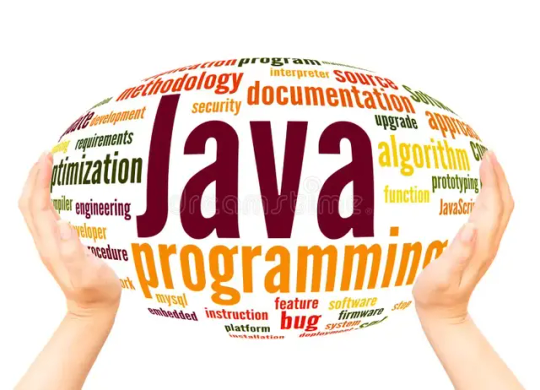
A Beginner's Guide to Programming in Java: A Human-Friendly Approach
Programming in Java can seem daunting at first, but with the right guidance and a step-by-step approach, anyone can learn to code in this powerful language. In this blog post, I will walk you through the process of programming in Java, explaining each step in a human-friendly manner. So, let's dive in and embark on this exciting journey together!
Step 1: Setting Up Your Development Environment To start programming in Java, you'll need to set up your development environment. Begin by downloading and installing the Java Development Kit (JDK) from the official Oracle website. Once installed, you can use any text editor or Integrated Development Environment (IDE) of your choice to write your Java code.
Step 2: Understanding the Basics of Java Syntax Java is an object-oriented programming language, which means it revolves around creating and manipulating objects. Familiarize yourself with the basic syntax of Java, such as how to declare variables, write loops, and define functions. Understanding these fundamental concepts will lay a solid foundation for your Java programming journey.
Step 3: Writing Your First Java Program Now that you have your development environment set up and a basic understanding of Java syntax, it's time to write your first Java program. Start with a simple "Hello, World!" program, which will display this classic message on the screen. This exercise will help you grasp the structure of a Java program and how to execute it.
Step 4: Learning Java Data Types and Variables Java offers various data types, such as integers, floating-point numbers, characters, and booleans, to store different kinds of information. Dive deeper into the world of data types and learn how to declare variables to store and manipulate data in your Java programs.
Step 5: Controlling Program Flow with Conditional Statements and Loops Conditional statements, like if-else and switch-case, allow your program to make decisions based on certain conditions. Loops, such as for, while, and do-while, enable you to repeat a block of code multiple times. Mastering these control structures will give you the power to create dynamic and interactive Java programs.
Step 6: Understanding Object-Oriented Programming (OOP) Concepts Java's strength lies in its object-oriented nature. Dive into the world of OOP and learn about classes, objects, inheritance, polymorphism, and encapsulation. These concepts will help you write modular, reusable, and maintainable code.
Step 7: Exploring Java Libraries and APIs Java provides a vast collection of libraries and Application Programming Interfaces (APIs) that extend its functionality. Discover popular libraries like Java Standard Library, JavaFX, and third-party libraries that can simplify complex tasks and enhance your Java programs.
Step 8: Debugging and Troubleshooting As a programmer, you'll encounter errors and bugs in your code. Learn how to effectively debug and troubleshoot your Java programs using tools like breakpoints, logging, and error handling techniques. Debugging skills are essential for every programmer's toolkit.
Step 9: Practicing and Building Projects The best way to solidify your Java programming skills is through practice. Start small by solving coding challenges and gradually move on to building your own projects. Join online coding communities, participate in coding competitions, and collaborate with fellow programmers to enhance your skills.
Congratulations! You've completed the step-by-step guide to programming in Java. Remember, programming is a continuous learning process, so keep exploring new concepts, experimenting with code, and challenging yourself. With dedication and practice, you'll become a proficient Java programmer in no time. Happy coding!
1 note
·
View note
Text
Shes an Apple engineer AND Victorias Secret model. These sexist trolls never stood a chance.
View this post on Instagram
CODING IS FOR ANYONE! @science @girlswhocode From @codingblog #coding #codinglife #codingisfun #codingpics #coder #coderlife #programmer #programmers #programmerslife #programmerlife #programmerhumor #programming #programmings #programminglife #programmingcontest
A post shared by Coding engineer (@coding.engineer) on Sep 6, 2018 at 9:47pm PDT
Lyndsey Scott has a resume that almost sounds too impressive to be true: she’s works as a tutor on Apple’s iOS team and is a software engineer. Full stop. That’s a career worthy of serious accolades.
But she’s also a celebrated Victoria’s Secret model.
And it’s her vocation as a model that led some deeply misguided sexist trolls to question the 31-year-old’s qualifications.
Big mistake.
Scott didn’t just “own” these would-be bullies, she did it with the facts. They say sunlight is the best disinfectant and her truth rays sent the cockroaches of the internet scurrying for cover.
Here’s how it all started: An Instagram post headlined ‘This Victoria’s Secret model can program code in Python, C++, Java, MIPS, and Objective-C.’ came under attack on a Reddit forum.
A few anonymous users questioned whether Scott was the real deal, mansplaining their way past any research or actual knowledge by assuming she wasn’t a “real” coder and was simply using the term to give herself an elevated sense of importance.
One user openly speculated that she had simply run a simple program that “programmed” the words “Hello, world.”
Another even more condescending user tried to explain the complexities of coding, something he assumed Scott clearly didn’t have a functioning grasp of:
“Anyone can write code, not many people can write code well though. Languages are easy to learn, but scalable, readable, maintainable, efficient code is not.”
Of course, the problem with all of this is that Scott is in fact an extremely qualified coder.
And while she noted that she normally chooses to not engage with hateful strangers online, in this case she felt it was important to clear the air. So, Scott jumped into the comments section of the Coding Engineer Instagram account and took on the role of anti-troll, writing:
I have 27481 points on StackOverflow; I’m on the iOS tutorial team for RayWendelich.com; I’m the Lead iOS software engineer for @RallyBound, the 841st fastest growing company in the US according to @incmagazine, I have a Bachelor’s degree from Amherst where I double majored in computer science and theater, and I’m able to live my life doing everything I love. Looking at these comments I wonder why 41% of women in technical careers drop out because of a hostile work environment 🤔 #gofigure
In a follow-up post on her own Instagram account, Scott wrote:
“I normally try to ignore negatively, but decided to jump into the comment section of this one. Not trying to brag lol, just stating facts in the hope I’ll convince at least one negative commenter that programmers can come in all shapes, sizes, genders, races, etc. so they’ll think twice before doubting other women and girls they encounter in tech.”
Scott shared her message across Twitter as well, where it was welcomed with open arms by other women in tech:
Looking forward to the day when women in tech don’t have to go above and beyond to prove themselves. 🙏 pic.twitter.com/MFe3RcKWKx
— Lyndsey Scott (@Lyndsey360) September 8, 2018
Shutting down sexist trolls is a worthy task in and of itself.
But like Scott said, reminding women that they have every right to succeed in their chosen field is an act worth celebrating.
Original Article : HERE ; This post was curated & posted using : RealSpecific
=> *********************************************** Source Here: Shes an Apple engineer AND Victorias Secret model. These sexist trolls never stood a chance. ************************************ =>
Shes an Apple engineer AND Victorias Secret model. These sexist trolls never stood a chance. was originally posted by Viral News - Feed
0 notes
Text
Shes an Apple engineer AND Victorias Secret model. These sexist trolls never stood a chance.
View this post on Instagram
CODING IS FOR ANYONE! @science @girlswhocode From @codingblog #coding #codinglife #codingisfun #codingpics #coder #coderlife #programmer #programmers #programmerslife #programmerlife #programmerhumor #programming #programmings #programminglife #programmingcontest
A post shared by Coding engineer (@coding.engineer) on Sep 6, 2018 at 9:47pm PDT
Lyndsey Scott has a resume that almost sounds too impressive to be true: she’s works as a tutor on Apple’s iOS team and is a software engineer. Full stop. That’s a career worthy of serious accolades.
But she’s also a celebrated Victoria’s Secret model.
And it’s her vocation as a model that led some deeply misguided sexist trolls to question the 31-year-old’s qualifications.
Big mistake.
Scott didn’t just “own” these would-be bullies, she did it with the facts. They say sunlight is the best disinfectant and her truth rays sent the cockroaches of the internet scurrying for cover.
Here’s how it all started: An Instagram post headlined ‘This Victoria’s Secret model can program code in Python, C++, Java, MIPS, and Objective-C.’ came under attack on a Reddit forum.
A few anonymous users questioned whether Scott was the real deal, mansplaining their way past any research or actual knowledge by assuming she wasn’t a “real” coder and was simply using the term to give herself an elevated sense of importance.
One user openly speculated that she had simply run a simple program that “programmed” the words “Hello, world.”
Another even more condescending user tried to explain the complexities of coding, something he assumed Scott clearly didn’t have a functioning grasp of:
“Anyone can write code, not many people can write code well though. Languages are easy to learn, but scalable, readable, maintainable, efficient code is not.”
Of course, the problem with all of this is that Scott is in fact an extremely qualified coder.
And while she noted that she normally chooses to not engage with hateful strangers online, in this case she felt it was important to clear the air. So, Scott jumped into the comments section of the Coding Engineer Instagram account and took on the role of anti-troll, writing:
I have 27481 points on StackOverflow; I’m on the iOS tutorial team for RayWendelich.com; I’m the Lead iOS software engineer for @RallyBound, the 841st fastest growing company in the US according to @incmagazine, I have a Bachelor’s degree from Amherst where I double majored in computer science and theater, and I’m able to live my life doing everything I love. Looking at these comments I wonder why 41% of women in technical careers drop out because of a hostile work environment 🤔 #gofigure
In a follow-up post on her own Instagram account, Scott wrote:
“I normally try to ignore negatively, but decided to jump into the comment section of this one. Not trying to brag lol, just stating facts in the hope I’ll convince at least one negative commenter that programmers can come in all shapes, sizes, genders, races, etc. so they’ll think twice before doubting other women and girls they encounter in tech.”
Scott shared her message across Twitter as well, where it was welcomed with open arms by other women in tech:
Looking forward to the day when women in tech don’t have to go above and beyond to prove themselves. 🙏 pic.twitter.com/MFe3RcKWKx
— Lyndsey Scott (@Lyndsey360) September 8, 2018
Shutting down sexist trolls is a worthy task in and of itself.
But like Scott said, reminding women that they have every right to succeed in their chosen field is an act worth celebrating.
Original Article : HERE ; This post was curated & posted using : RealSpecific
=> *********************************************** Post Source Here: Shes an Apple engineer AND Victorias Secret model. These sexist trolls never stood a chance. ************************************ =>
Shes an Apple engineer AND Victorias Secret model. These sexist trolls never stood a chance. was originally posted by 16 MP Just news
0 notes
Text
Getting Started with Spring Cloud Stream using Spring Initializr
Thanks to Spring Cloud Stream and Spring Initializr it is easier than ever to develop event-driven microservices. Even with partner-maintained binders like Solace PubSub+! If you’re not familiar with Spring Cloud Stream or Spring Initializr, this post will provide some quick background info as well as a tutorial so you can try it yourself.
The Spring Cloud Stream Framework
There are a number of Spring projects for building applications of all types. When developing scalable event-driven microservices, Spring Cloud Stream is often the framework of choice as it provides a flexible programming model and allows developers to create event-driven microservices without having to learn messaging APIs. Instead of learning messaging APIs, Spring Cloud Stream just requires developers to learn basic message-driven concepts such as publish-subscribe and consumer groups. The framework leverages cloud stream binders, which exist for several message brokers including Solace PubSub+, Apache Kafka, and RabbitMQ.
PubSub+ and Spring Initializr
The Solace PubSub+ Spring Cloud Stream binder is automatically added to Spring Initializr projects when you choose both the Solace PubSub+ and Cloud Stream dependencies. For those who are not familiar with start.spring.io, it allows developers to generate Spring Boot projects pre-populated with the dependencies they need to get started quickly.
There are a couple scenarios that could play out when generating a project with Solace PubSub+ as a dependency using Spring Initializr:
Your dependencies include Solace PubSub+, but do not require a binder.
Your dependencies include Solace PubSub+ AND Cloud Stream, which states that it requires a binder.
In scenario 1, Spring Initializr adds the solace-spring-boot-starter to your project. This starter allows you to use Spring Boot with either the Solace JMS API or the Solace Java API (JCSMP).
In scenario 2, Spring Initializr realizes you’re trying to create a Spring Cloud Stream microservice and automatically includes the Solace Spring Cloud Stream Binder Starter in your project.
Using Solace with Spring enables microservices created using the Spring ecosystem to communicate with both Spring and non-Spring applications across multi-cloud, hybrid-cloud, and no-cloud environments.
5-Minute Tutorial (seriously, only 5 minutes)
Do you already have a JDK, Maven, and Docker installed? If so, it will only take you 5 minutes (video evidence here!). So, why not give it a try for yourself!
If for some reason you can’t use Docker, check out this codelab for how to do it using PubSub+ Cloud.
Let’s Begin…
Deploy a Solace PubSub+ Event Broker via Docker
docker run -d -p 8080:8080 -p 55555:55555 -p:8008:8008 -p:1883:1883 -p:8000:8000 -p:5672:5672 -p:9000:9000 -p:2222:2222 --shm-size=2g --env username_admin_globalaccesslevel=admin --env username_admin_password=admin --name=solace solace/solace-pubsub-standard
Go to start.spring.io and add the Solace PubSub+ and Cloud Stream dependencies. Yes, that link added them for you 😜.
Click Generate
Unzip the downloaded zip file and import into your IDE as a Maven project
Open DemoApplication.java and add the following Spring bean
@Bean public Function<String, String> uppercase(){ return v -> { System.out.println("Uppercasing: " + v); return v.toUpperCase(); }; }
Save and Run*
Navigate to the Try-Me! menu item in your local PubSub+ Manager which deployed with the Docker container in Step 1. Your username/password are admin/admin by default.
On the Subscriber side, click Connect, type uppercase-out-0 in the Subscribe to a topic to receive direct messages box and click Subscribe.
On the Publisher side click Connect, type uppercase-in-0 as the topic to publish to and click the Publish button.
Boom! You’re done! Was that simple enough?
*You may be thinking, “What! No connection info needed?!” That is correct. By default, the Solace Binder knows how to automatically connect to the local docker container!
Behind the Scenes
Okay, so you followed the steps above, but what exactly happened? Let me explain:
You deployed a Spring Boot microservice which contained a java.util.function.Function bean in your code and both the cloud stream and a cloud stream binder as dependencies. This told Spring Boot that you wanted to create an event-driven microservice using Spring Cloud Stream.
After Spring Boot realized you wanted a Cloud Stream microservice it knew it needed to create cloud stream bindings to exchange events with the available broker. So, based on your function name of uppercase, it created the default input binding of uppercase-in-0. The Solace Cloud Stream binder then subscribed to the uppercase-in-0 topic on the Solace PubSub+ Event Broker.
When you published an event in the Try-Me! tool, you published an event to the uppercase-in-0 topic on the Solace Broker that contained a payload of “Hello world!”
Your microservice received this event via the binding previously set-up, identified the payload as a String type, and called your uppercase bean for processing which converted the payload of “Hello world!” to “HELLO WORLD!” and returned a String.
Spring Cloud Stream included that returned String as the payload in an outbound message to the Solace Binder which in turn published it to the uppercase-out-0 topic on the Solace Broker.
The Try-Me! tool was then able to receive the processed message and display it to the screen.
What should you try next?
Read about how to use AsyncAPI to generate a Cloud Stream app
Learn how Solace works with Spring Initializr at start.spring.io
Check out this codelab for some more Cloud Stream Fundamentals and to extend what you did here with Function Composition:
Watch our recent Live Coding session featuring Oleg, a lead developer on the Spring Cloud Stream project.
Code for the open source Solace PubSub+ Spring Cloud Stream Binder can be found in the github repository below
The post Getting Started with Spring Cloud Stream using Spring Initializr appeared first on Solace.
Getting Started with Spring Cloud Stream using Spring Initializr published first on https://jiohow.tumblr.com/
0 notes
Link
Credit: Adam Sinicki / Android Authority
While Java is one of the most in-demand and widely used programming languages in the world, it is not without its detractors. Java is not a particularly beginner-friendly language and it is rife with rigid rules and structures that can be tough to wrap your head around. Then there’s the NullPointerException.
Null pointer exception is an “exception” (error) that is particularly common when programming in Java. For a beginner, this is a confusing and daunting message to receive, but it can be just as much of a headache for pros to deal with! In fact, null pointer exceptions are so common and so damning, that they are referred to as “the billion-dollar mistake.” Ouch!
In this post, we’re going to unwrap the phrase to discover exactly what it means and what you should do when you encounter a null pointer exception in your own code!
What does null pointer exception mean?
First, we need to understand precisely what is meant by a pointer and how it can be null!
To do this, it helps to remember that a variable is actually a “pointer” that tells the computer to look at a certain location. That location will then contain a value, which is the value of the given variable.
So, if we say “int x = 3” then the computer will choose a location to call “x” and it will store the value “3” there. Whenever you refer to x further on in your code, the computer will look at that location and see that it is a “3” (unless you changed it). The variable points the computer to the right destination.
See also: Understanding variables in Java
This is why it’s useful to know the potential size of a variable first, as it tells the computer how much space to allocate for that value.
But what happens when you have a pointer that doesn’t point anywhere? That’s where the null pointer exception comes in.
Objects and references
An integer like “x” is what we call a “primitive type.” That means that it is a fundamental value.
An object, on the other hand, is a more complex data structure that can have multiple values and methods. Like primitive types, however, they still need to be stored somewhere and they still need an address and a pointer.
An example is String. This is not a primitive type in Java, but rather a reference type: in this case it “points” to a class that can have multiple values and methods. Once you have initialized an instance of a string, you can do things like:
myString.length();
This will tell you how long said string is by using the method that belongs to that class. But this is also what makes the null pointer exception possible because “length()” is a value that refers to a specific instance of an object. That means it acts on a specific string once it has been created.
Thus, you need to say:
String myString = “Hello”; myString.length();
But were you to say:
String myString = null; myString.length();
You would have created a pointer (myString) but that pointer does not point anywhere – it doesn’t know where to look. Another way to say this? The pointer is null.
The key thing to understand is that it is not that there is no value, but rather that the variable isn’t pointing anywhere for there to be a value.
There are certain coding design patterns that benefit from the ability to assign null values, so it’s a useful feature in those circumstances. As long as you remember that the object is null!
How to prevent null pointer exceptions Java
The reason that null pointer exceptions are so unpopular in Java is that they are runtime exceptions. That means the app will compile just fine and you’ll only hear about them when you reach that point in the code. It is, therefore, possible for a null pointer to slip through the net if you are initializing lots of objects on the fly.
This is why it’s useful to include measures to prevent null pointer exceptions during runtime.
The easiest way to do this?
if (myString == null) { return; }
This will help you to quickly check if an object is null, thereby circumventing code that would throw an exception. There are other tricks you can use, too. For example, when comparing strings, it’s a good move to invoke the method from the string literal, rather than the other way around:
If(“Hello!”.equals(myString)) {
Rather than:
If(myString.equals(“Hello!”)) {
You will avoid throwing an exception this way. OR you could just use Kotlin, which is “null safe” by design!
See also: Kotlin tutorial for Android for beginners: Build a simple quiz
Want to learn more about writing well-designed, flawless Java code? Then check out our guide to the best resources to learn Java. Or why not get started with our free, comprehensive Java tutorial for beginners?
source https://www.androidauthority.com/null-pointer-exception-1156263/
0 notes
Text
How to start Android app development for beginners?
Android app development
Learning to code is difficult enough on its own but with Android development, it can be more complicated. You need to understand Java, you also need to install all the Android-specific software and learn all of the unique quirks of Android app development. Let’s check out how to start Android app development for beginners?
Creating an Android app requires the SDK (Software Development Kit), an IDE (Integrated Development Environment) like Android Studio or Eclipse, the Java Software Development Kit (JDK) and a virtual device to test on. All this takes work to set up, and that’s before you’ve even started looking into things like Google Play Services, screen sizes, API levels…It’s just such a dense amount of information and it’s enough to put an awful lot of people off before they even begin. Through this article, you will learn an approachable guide to try and make the whole prospect of creating an app a little less daunting… let’s explain the bits you need to know and gloss over the rest and by the end, you should have a basic app that you can start iterating on and experimenting with.
Step 1: Get Android Studio
To program in most languages, you need a piece of software called an IDE or ‘Integrated Development Environment’. The most common IDE for Android development is Android Studio, which comes directly from Google itself. You can get it here.
An IDE is what gives you the main UI where you’ll enter your code (you can’t just start typing into notepad). It also highlights things you get wrong, offers suggestions and lets you run and test your creations conveniently. It creates the files you need, it provides basic layouts and generally it saves you a lot of time and effort.
What’s great about Android Studio is that it is designed specifically for Android development (unlike the second most popular option, Eclipse). This means that when you download the software, you’ll also get a lot of the other bits you need including the Android SDK (a selection of tools including the Android platform itself) and the Android Virtual Device, which is an emulator you can test your apps on. When you go through the installation, make sure you leave the boxes ticked to confirm that you want these additional components. You could manually add them later, but this will just complicate matters.
As mentioned, there are some alternatives to Android Studio. Eclipse is an older IDE that can be used for developing other things too (such as iOS apps) and that is a bit more flexible overall. It’s also a much more fiddly to get started with though and not nearly as beginner-friendly.
we now have Android Studio downloaded and installed. But, don’t run it until you read step two! So far so good…
Step 2: Setting Up Android Studio
Now you have Android Studio installed you’ve taken your first, bold step toward becoming a developer! A lot of people only manage it this far and then leave the software installed on their computer for months on end, feeling guilty every time they see it in the Start Menu. Eventually, they end deleting it to make space for the next AAA title on Steam and so ends the whole sorry affair… Don’t end up like them – it’s time for some more affirmative action!
Before you can get started, you also need to install Java on your machine to use Android Studio. Specifically, you’re going to need to install the Java Development Kit (JDK). Java is the programming language you’re going to be using to build your apps in this instance and you need to install the JDK in order for Android Studio to be able to interpret and compile your code (compiling means turning the source into something that is understood by the CPU – machine code). You’ll find the Java Development Kit here. Just download and follow the instructions to install.
Now you can click on Android Studio to launch it. Once it opens up, you’ll be presented with a menu where you’ll be able to get started or configure some options. The great thing is that everything is handled for you at this point, though you may want to familiarize yourself with the SDK Manager (Configure > SDK Manager) which is where you’ll update your Android SDK to support newer versions, as well as download things like code samples or support for Google Glass. But don’t worry about that now but if Android Studio says you’re missing something, this is where you’ll probably need to go to find it.
So really there are three main things interacting when you use Android Studio to create your apps.
Android Studio itself, which is an IDE that provides you with a nice interface for coding.
The code you write in Java, which you installed a moment ago…
And the Android SDK which you’ll access through your Java code in order to do Android-type things
If you find this all a bit complicated and daunting then… well, you will be familiar with this awesome opportunity.
Step 3: Starting a New Project
Once you’ve installed your samples, you can go back to the first page you saw when you loaded up Android Studio. Now you want to choose to Start a new Android Studio Project – it’s finally happening!
Enter the name you want for your application and your ‘company domain’. Together these elements will be used to create your package name with the following format:
com.companyname.appname
The package will be the compiled file or APK (‘Android Package File’) that you’ll eventually upload to the Google Play Store. There are ways that people can see this.
The last field to enter is the directory where you want to save all the files pertaining to your app. always have a backup of code. Click Next again.
Next you need to decide what type of device you’re going to be developing for and in this case, we’ll start with the Phone and Tablet option. Other options are TV, Wear and Glass. It’s fine if you want to develop for a myriad of platforms in the future – that’s one of the wonders of Android –
The other choice you have to make at this stage is the ‘Minimum SDK’. This is the lowest version of Android you want to support. Why not just enter the latest version of Android in here? Well, because relatively few people actually have the latest version of Android installed on their device at any given time. You want to support phones that are still running older versions in order to reach the largest possible audience – especially overseas.
The best bet at this stage is to go with the default option, so just leave this field as it is. On the next page, you’ll be given the option to pick the way you want your app to look at the start. This will be the look of your main ‘Activity Module’ which is basically the main page of your app. Think of these like templates; do you want to have the title of your app along with the top of the screen, or do you want your UI to fill the whole display? Do you want to start off with some elements ready-designed for you? Is your app primarily going to use Google Maps (don’t go here for a bit, things get more complicated with Google Play Services)?
The Layout
Android Studio is not showing the XML code itself here but rather a rendering of how the layout will appear on the screen. This is a visual editor a bit like Dreamweaver for web design and it makes life a little easier for us developers.
You also have a bunch of options called ‘widgets’ down the left that you can add to your app. This is your basic app stuff; so for instance, if you want to add a button saying ‘OK’ to your activity, you can simply drag it over to the screen and drop it anywhere you like. Go ahead and dump an ‘OK’ button right underneath the ‘Hello World’.
Something else you’ll find is that you can click on either of these elements in order to change the text and the ‘ID’. The ID is how you’re referring to each element (called a ‘view’) in your Java code, while the text is of course what you display to the user.
Delete the ‘Hello World’ widget (or view) and change the text on the button to ‘Hello?’. Likewise, change the ‘id’ on the button to ‘button1’.
I am now stealthily getting you to write a little program… Notice as well that when you select a view, you get options in the bottom right to change the text colour and size etc. You can play around with these variables if you like to change the look of your button. We’re coming back here in a minute though so make a mental note!
Now open up your MainActivity.java. The tab will be along the top but in case it isn’t, find it under App > Java.
This is the code that defines the behaviour of your app. At this stage, you’re going to add in a little passage of code:
Now all that’s left to do is run the app you just made. Simple go to ‘run’ along the top and then select ‘run app’ from the drop-down menu. You should already have your AVD (Android Virtual Device) installed but if not, you can go to tools > Android > AVD Manager > + Create Virtual Device. Don’t forget you also need to install an Android version onto the device.
Follow the steps to launch the emulator running your app. Be patient, it can sometimes take an age to load up… If it never loads up, you can consider ‘packaging’ the app in order to create an APK. Drag this onto your Android device and double click on it to install and run it.
How to get better app development with Mango Digital?
If you want the absolute easiest way to start, then just find some sample code that’s close to what you make and change. Try changing the layout of the text and try adding in more buttons and more rules to make your app actually useful.
#android app development#android app development course#android app development for beginers#android app development kit#android app development tutorial
0 notes
Text
application programming
What do I need to start learning Android application programming? Learn programming Android applications
In fact you do not need anything luxurious or a computer with super specifications, or even all of these devices that we mentioned earlier, you only need the will and determination to learn.
Your choice to develop applications for the Android system opens two doors in front of you, the first door is programming using the Java language, which is a powerful and well-known language which is the official language approved by Google to develop applications of this system.
The second section is broader and goes beyond the idea of application programming only, but you can develop web pages because it depends on the HTML5 language, JavaScript and a little bit of CSS.
Chapter one and nothing is better than official Create Android apps
Google provides a development environment called Android Studio in which tools are provided to create an application that is fully compatible with all devices, whatever their specifications, size or type of screens. Using this environment, an application can be developed on tablets, smartphones and the rest of the devices that use this system without the need to write Application intended for each platform.
At the same time, the company provides a set of educational lessons for how to start making the first application, and if you are a programmer then it is no secret to you that the first application will print for you the words “Hello World”.
and what ? Google offers you only the first door key and leaves the space in front of you to explore this world alone, and you are the one who ultimately decides the number of steps you want to skip inside.
After familiarizing with the basics of dealing with the Android environment, it is recommended to focus on the Java language first, and the sources for learning this language are very many, among the best are the free Stanford University course, you can then follow it with the TUT + site, which provides a free and paid series of lessons for professionalism of the Java language and an understanding of the mechanism that Work it out.
And because the official sources are the best, the instruction manual for this language can be found from the official language developer Oracle website.
Last but not least is The New Boston and Head First Labs, where the latter provides a full book of Java education for free.
Also read: Learn Web Development, The Right Way!
Return to the Android galaxy How to program Android applications
After you fully know the Java language and the Android development environment, you are now almost eligible to fly high in the Android sky, and you need to get to know more about the existing libraries that allow you to fully handle the components of the device.
Thanks to these libraries, by writing only two lines, you can operate the camera after pressing the button you have placed inside your application. Yes, things are that simple.
Coursera offers a free course to teach dealing with Android libraries and building sophisticated applications that store data within databases.
SlideRule also offers this type of tutorial for free, as the course offers 50 hours of learning time with tests to solve some questions that allow you to develop your skills.
Finally, the Android book is simply one of the distinguished books, it is written in Arabic and in a fun style, but it has been around for four years, so the information inside it is old, but it is enough to explain the mechanism of making applications and the general structure of any application within the Google Play Store.
Amazon store is also full of books, where you can buy books to teach Android application programming for no more than $ 30 USD, and what distinguishes these books is that they are constantly updated and therefore always covers the latest programming technology offered by Google.
And if you want to access affordable paid online courses then there is nothing better than udemy academy or vogella.
Indeed, the sources of Android education are endless. You can search in YouTube and Google to access a new source every day, but the previous sources are characterized by the presence of a full study plan covering most of the Android tools, and the user will not find himself waiting for the next lesson without coming.
Hassoub Academy: Mobile Application Development Course using Web Technologies
Have you brewed the idea with your head now, and increased your enthusiasm to explore the depths of the world of Android mobile application programming, but you were distracted between multiple sources, theoretical explanation, and the English language was an obstacle in front of you? Well, now the Hassoub Academy promises you that you will become a “Mobile App Developer” without having to have any previous experience, after completing the course (Mobile App Development Using Web Technologies) .. Are you ready?
After completing the course, you will be able to work with the Cordova platform - the most used platform in building mobile applications with web technologies - and build one application that works on Android and iPhone at the same time, in addition to professional dealing with the Framework7 framework.
The course is completely practical, where you will learn - in practice - how to build a real news application related to the WordPress system, as well as develop a professional application for managing tasks. The duration of the course is 18 hours, and at the end of it the learner obtains an accredited certificate from Hassoub.
Are you curious? You can learn this way My curiosity always drives me to an important question, How does a doctrinal application work? Or what steps can I create such an app?
After getting to know all the libraries and how to deal with them, you may be puzzled about the best way to use them inside your application. Here comes the role of Codota, which provides the source code for more than 7 million Android applications.
What distinguishes this site is the ability to review applications according to the libraries that you use, so if you want to know the real employment of the dealing library databases, you can easily go to the SQLite Database section and read the code for some applications that are already inside the Google Play Store.
app programming
0 notes
Link
Learning to code C#? We have provided HD video lectures, live coding sessions, and nearly 100 exercises to learn on!
What you’ll learn
Understand the foundations of the C# Programming language
Create applications that run in the console
Declare and manipulate variables
Write flow of control statements (loops & conditions)
Create methods for code reuse and readability
Organize your code into related classes
Almost 100 warm up exercises to practice language fundamentals
Requirements
Basic Computer Skills (Typing, File Browsing)
Description
WANT TO PROGRAM? START FAST — LEARN TO WRITE C# CODE
“If you want a good beginning C# course, this is the one for you!”
The content of the course is delivered in a very clear manner by a programming instructor who really seems to know his stuff. Additionally, the instructor actively answers student questions posted in the course discussions. If you want a good beginning C# course, THIS IS THE COURSE FOR YOU!!! — Jake Jones
Here’s the BEST COURSE CHOICE for raw beginners who want to learn computer programming.
This is the BEST COURSE CHOICE for raw beginners — anybody who wants to write a little code — or a lot of it! And it’s especially right for anyone who dreams of becoming a software programmer but hasn’t the faintest idea of how to begin.
Here’s great news: If you can type, install a program using a Wizard, and open the File Explorer, you’re ready to begin.
It’s true. If you have a computer (or access to one), have typing ability, and know how to browse files, YOU can learn to program one of today’s most popular and fastest-growing computer platforms, C#. Yes, you could learn C# online and become a successful software programmer with our C# course, “Programming for Complete Beginners in C#.”
What is C#…
First, say C# like this: “See Sharp,” just like the music note. When it comes to computer programming language, C# is the best place for a newbie to start. Why? Because it’s simple to learn, well supported and maintained, and extremely versatile.
…and WHY should I take this C# course?
You’re a newcomer to coding? Your job is to LEARN THE CODE and that’s what this online C# course is all about. You’ll learn C#’s programming language, its syntax, with clear instruction and detailed videos. And you’ll write code. Lots of code.
Learning the code is Job 1. That’s what this course will teach you. Later comes problem solving, and learning how to create and organize large-scale solutions that are reusable, testable, and of high quality. But all that’s later.
Want to program? You MUST learn to write code
The BEST way to become a highly proficient C# programmer is to write code — LOTS of code. And you’ll be writing, writing, and writing in this highly focused course. You’ll get limber with nearly 100 warm up exercises you’ll use to practice and increase your fluency in C# language fundamentals.
You’ll receive and own over 48 lectures, eight quizzes, and more than six and a half hours of focused content — complete instruction on how to understand the solid foundation of C# Programming language.
Get ready to dive right into the code because you’ll actually create real, live applications that run in the console. You’ll get in there and declare and manipulate variables. You’ll write “Flow of Control” statements we call “Loops and Conditions.”
On your path to becoming an expert programmer, will learn how to create methods for code reuse and readability. Cool! And you’ll keep it all nice an neat by learning to organize your code into related classes.
You’re about to learn the secrets of today’s most powerful and popular programming language
You’ll start your C# course with a full overview of C# — our “sales pitch” on why it’s today’s must-learn programming language. Then we’ll show you how to download and install Visual Studio Express.
You’ll start your first code-writing lesson by writing the classic “Hello World” to your screen. Pay attention because there’s a Quiz afterward! Having written it, you’ll then deconstruct your Hello World application so you can see the bits and pieces that form a C# application.
You’ll learn new lingo starting with “Types.” In C#, everything is a type — they define all interactions between objects, variables, and parameters. (Lost in the lingo already? Don’t worry about it. C# language is easy to learn and it’s all in our C# online course.)
You’ll watch a detailed, seven-minute demo videos so you can learn about reading data from the console. And then a 15-minute video demo demystifying “Comments and Format Settings.”
You’ll continue watching, learning, and being grilled on your knowledge. We’ll explain and demonstrate “Expressions and Operators.” And quiz you on them, too. Learn about “If Statements.” Discover “Live Coding” in our chapters, “Flip a Coin 1 and 2.” Then “Lucky Sevens.” Check it out!
You’ll learn about “For Loops,” “Conditional Statements & Loops, Classes & Methods and much, much, much, much more…you’ll learn all about C# in ten sections and 56 chapters in all.
Here’s why learning C# is the KEY BUILDING BLOCK of your programming foundation:
Here’s WHY almost 3,000 people just like you are learning C# through our online course…and why we recommend C# so highly for those who’re new to programming:
Java is a programming language many adore but C# is even better. It offers those new to programming many, many advantages. It’s growing in popularity with programmers by leaps and bounds. That’s a trend we’ve seen for many years — C# is becoming more and more popular every year.
Learning C# programming language makes it easier for you to understand other C-based programming languages. (Just like learning to speak Spanish helps you understand Italian.) And there are many, many very valuable C languages in the C family including C, Java, C++, Objective –C, and more.
And how about job opportunities? In Cleveland, for example, 98% of C# programmers enjoy gainful employment in their field. C# programmers are in high demand! C# runs on multiple platforms. Windows? Linux? iPhones? Androids? You betcha.
C# was created and is maintained by Microsoft so you know it gets plenty of support. This software giant is continually adding new and more potent C# features including new versions of C#’s Visual Studio. And the Visual Studio toolset is widely regarded as the #1, A+, five-star, gold-plated, best development environment on Planet Earth.
C# runs on the .NET framework (say, “dot net”). It’s what pros call a “consistent object-oriented programming environment,” that’s rock-steady for creating web and desktop applications. In fact, no matter what kind of application you’ll build, you’ll find C# will make it steady and stable across all computer platforms.
Apps? How many and what kind will you develop? No holds barred because C# handles apps for desktop, Windows Store, web apps, mobile apps, iPhone and Android apps, web and data services, and these are just for starters.
C# makes it easy to deploy and version your code saving you countless sleepless nights. It has a built-in safety net – a “sandbox” – to help you avoid the horrors of the dreaded, dead-on-arrival, pull-the-plug “blue screen of death” when your program crashes the operating system beyond all hope.
Who this course is for:
Complete Beginners
No really, if you can type, install a program using a wizard, and open the file explorer you are good to go!
Created by Eric Wise Last updated 9/2018 English English
Size: 408.40 MB
Download Now
https://ift.tt/39djycP.
The post Programming for Complete Beginners in C# appeared first on Free Course Lab.
0 notes